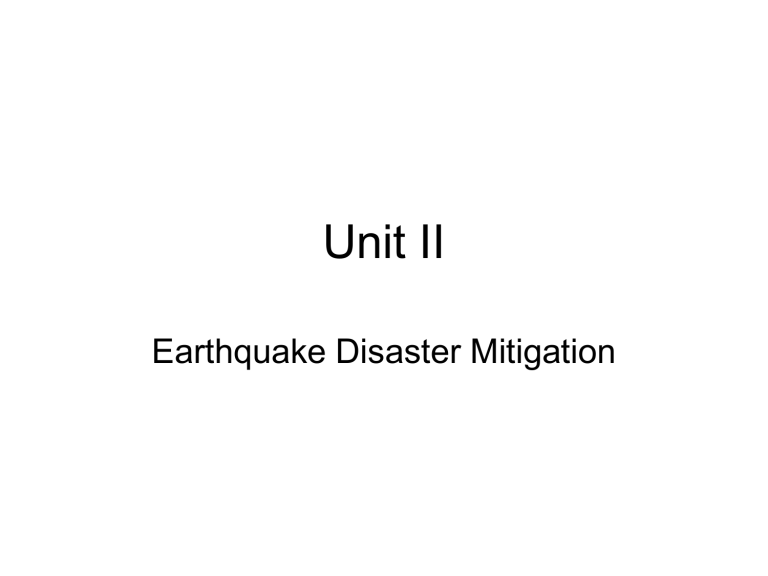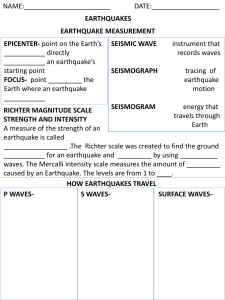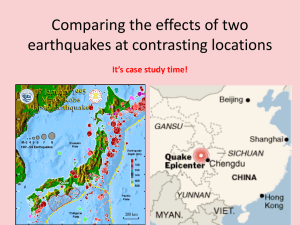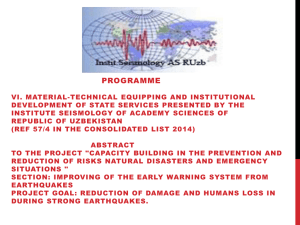Lecture 2

Unit II
Earthquake Disaster Mitigation
EARTHQUAKES
Source: Kobe I EERI - Slide #43
Earthquakes are a natural phenomena, like drought, flood and Cyclones.
Earthquakes in simple terms is a sudden trembling or shaking movement of the earth surface .
Larger earthquakes usually preceded by tremors and some violent shocks and followed by smaller earthquakes of diminishing size called aftershocks.
What are Earthquakes?
Source: www.earth.leeds.ac.uk/dynamicearth
A
sudden release of energy accumulated in deformed rocks causing the ground to tremble or shake.
- Causes rupturing or brittle failure of crustal rocks.
- Energy is released.
- Movement of fault blocks takes place along a fault plane .
INSIDE EARTH
Source: www.thetech.org
MANTLE
The region just below the crust and extending all the way down to the Earth's core is called the mantle. The mantle, a dense, hot layer of semi-solid rock approximately 2,900 km thick.
Layers of the Earth
By analyzing the seismograms from many earthquakes, scientists have discovered that three main levels or shells exist within the Earth:
CRUST
The Earth's outermost surface is called the crust. The crust is relatively light and brittle. Most earthquakes occur within the crust.
Scientists believe that below the lithosphere is a relatively narrow, mobile zone in the mantle called the asthenosphere (from asthenes,
Greek for weak).
CORE Beneath the mantle is the Earth's core.
The Earth's core consists of a fluid outer core and a solid inner core .
Local convective currents in the mantle
BASIC TERMINOLOGY
Earthquake
Hypocentre or focus
Epicentre
Focal depth
Epicentral distance
Origin time
Foreshocks and Aftershocks
Fault
Types of inter plate boundaries
Types of Faults
CAUSES OF EARTHQUAKES
• Plate Tectonics and Elastic Rebound
Theory
• Earthquakes due to volcanic activity
Major Tectonic plates on the Earth’s surface
SIZE OF EARTHQUAKES
Earthquake Intensity
• Oldest measure of earthquake size
• Qualitative description
• Depends on
– Distance of the site from epicenter
– focal depth
– Magnitude of earthquake
– Soil condition
• The intensity is maximum near the epicentre and decreases with increase in distance from the epicentre.
INTENSITY
Intensity is a qualitative measure of the actual shaking at a location during an earthquake and it is assigned in Roman Capital Letters
There are many intensity scales. Two commonly used ones are
1) Modified Mercalli Intensity (MMI) Scale.
2) MSK Scale
Both scales are quite similar and range from I(less perceptive) to
XII (most severe)
The intensity scales are based on three features of shaking
- perception by people and animals
- performance of buildings
- changes to surroundings
Basic Difference : Magnitude versus Intensity
Reducing illumination with distance from an electric bulb
Earthquake Magnitude
• It is measured on Richter Scale and is related to the logarithm (base 10) of the amount of energy released by an earthquake.
• The magnitude M of an earthquake is related to the energy released at the focus of the earthquake, and is given by the approximate formula
Log E ( ergs) = 11. 8 + 1.5 M
• The smallest earthquake perceptible by human being corresponds to the magnitude of 2
• largest and most destructive earthquake so far known to have occurred has been assigned a magnitude 8.7.
• The damage from an earthquake starts from magnitude 5 and above.
• Earthquakes are often classified into different groups based on their size
SEISMIC WAVES
Seismic waves are of two types
- Body waves
- Surface waves
Body waves consist of Primary waves (P-waves) and
Secondary waves (S-waves)
Surface waves consist of Love waves and Rayleigh waves
Arrival of seismic wave at a site
Types of Waves
Fastest waves
Do not travel through liquid
Seismic Hazards
• Ground shaking
• Structural hazards
• Liquefaction
• Landslides
• Retaining structures failure
• Lifeline hazards
• Tsuanami
Classification of earthquakes
• Based on location
– Interplate
– Intraplate
• Based on epicentral distance
– Local earthquakes
– Regional earthquakes
< 1º
1 10 º
– Teleseismic earthquakes > 10º
• Based on Focal depth
– Shallow depth 0-71 km
– Intermediate depth
– Deep earthquake
• Based on Magnitude
– Micro earthquake
71-300 km
> 300km
– Intermediate earthquake 3-4.9
– Moderate earthquake
– Strong earthquake
– Major earthquake
– Great earthquake
< 3
5-5.9
6-6.9
7-7.9
> 8
Indian Subcontinent: among the world’s most disaster prone areas
65% of land vulnerable to Earthquakes
8% of land vulnerable to Cyclones
5% of land vulnerable to Floods
> 1 million houses damaged annually + human, social, other losses
PAST EARTHQUAKES IN INDIA
Seismic Zone
Map of
India:
Year-1962
Seismic Zone
Map of
India:
-1966
Seismic Zone
Map of
India:
-1970
Seismic Zone
Map of
India:
-2002
About 65 percent of the land area of India is liable to seismic hazard damage (about 26% under MSK Intensity
VII, 18% under VIII and
12% under IX and higher).
•Hazard
Earthquake Risk
= Probability of ground motion
•Site effects = Soil properties, topography presence of Reservoirs (RIS),
Mines (MIS)
•Vulnerability = Building types, Age
•Risk = Hazard x Site effects x Vulnerability
Earthquake Don’t Kill
People but
Buildings Do
VULNERABILITY
• 1819 Gujarat [Kutch] 8.0 (2000 deaths)
• 2001 Gujarat [Bhuj] 6.9 (13805 deaths)
• Increased vulnerability in two centuries
EFFECT OF SEISMIC FORCES
ON STRUCTURES
• Inertia Forces in Structures
– From Newton’s First Law of Motion, even though the base of the building moves with the ground, the roof has a tendency to stay in its original position
– If the roof has a mass M and experiences an acceleration a , then from inertia force = Ma ( direction is opposite to acc.) Clearly, more mass means higher inertia force. Therefore, lighter buildings sustain the earthquake shaking better.
• Stiffness forces
– The inertia force experienced by the roof is transferred to the ground via the columns, causing forces in columns.
– During earthquake shaking, the columns undergo relative movement between their ends
– when forced to bend, they develop internal forces
– The larger is the relative horizontal displacement u between the top and bottom of the column, the larger this internal force in columns.
– Also, the stiffer the columns are ( i.e., bigger is the column size), larger is this force
Flow of inertial forces to foundation
Structural elements and connections must be designed to transfer the inertial forces through them
Twisting
Location of Building








